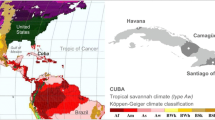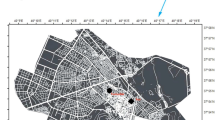Abstract
Altered characteristics of urban microclimates elongating the daily and seasonal exposure periods to heat stress and enlarging the size of the thermal uncomfortable urban surfaces. This situation is human thermal comfort conditions negatively which in turn affect public health and wellbeing. The aim of this study is to determine the spatial distribution of thermal comfort conditions in the neighbourhood of Yakutiye, the center of Erzurum city over the hottest 2 months of the year (July and August) based on long term (2004–2020) meteorological data to show the impact of urban areas on thermal comfort conditions where structured surfaces are dominant. PET index was used to calculate thermal comfort conditions through RayMan model and ArcGIS 10.5 software for their spatial distribution. It was seen as the result of the study that solar radiation and wind are two effective factors on thermal comfort contrarily to each other depending on the characteristics of the city in the mentioned period. Overheating by solar radiation due to concrete structured urban surface is tolerated by north-easterly cool winds. However, lack of moisture source (i.e. green areas) to moderate heat and cold stress is one of the main causes of thermally uncomfortable periods and areas in the city center. In order to improve such negative conditions, mitigating efforts should be focused on creating city parts that comply with spatial planning and design principles, taking into account all natural and human factors from a geographical perspective.











Similar content being viewed by others
Availability of Data and Materials
The datasets generated during and/or analysed during the current study are available from the corresponding author on reasonable request.
References
Akbarı, H., Pomerantz, M., & Taha, H. (2001). Cool surfaces and shade trees to reduce energy use and improve air quality in urban areas. Solar Energy, 70, 95–310.
Azeri, A. R. K., Akbarnıa, E., Molume, F. K., & Kolavani, S. S. K. (2015). The effect of green spaces on cities with health and efficiency approach. Cumhuriyet University Faculty of Science: Science Journal (CSJ), 36(3), 4217–4223.
Błażejczyk, K., Baranowski, J., & Blazejczyk, A. (2018). Climate related diseases. Current regional variability and projections to the year 2100. Quaestiones Geographicae, 37(1), 23–36.
Boukhabla, M., & Alkama, D. (2012). Impact of vegetation on thermal conditions outside, Thermal modeling of urban microclimate, Case study: The street of the republic, Biskra. Energy Procedia, 18, 73–84.
C40 Cities. (2012). Retrieved from https://www.c40.org/ending-climate-change-begins-in-the-city. Accessed 08 Mar 2023
Çağlak, S. (2024). A new model approach to map** bioclimatic comfort conditions. Theoretical and Applied Climatology. https://doi.org/10.1007/s00704-023-04816-3
Chapman, S., Watson, J. E., Salazar, A., Thatcher, M., & McAlpine, C. A. (2017). The impact of urbanization and climate change on urban temperatures: A systematic review. Landscape Ecology, 32(10), 1921–1935.
Chen, L., Ng, E., An, X., Ren, C., Lee, M., Wang, U., & He, Z. (2012). Sky view factor analysis of street canyons and its implications for daytime intra-urban air temperature differentials in high-rise, high-density urban areas of Hong Kong: A GIS-based simulation approach. International Journal of Climatology, 32, 121–136. https://doi.org/10.1002/joc.2243
Cleugh, H., & Grimmond, S. (2012). Urban climates and global climate change. In A. Henderson-Sellers & K. McGuffie (Eds.), The future of the world’s climate (2nd ed., pp. 47–76). Elsevier. https://doi.org/10.1016/B978-0-12-386917-3.00003-8
Cohen, P., Potchter, O., & Matzarakis, A. (2012). Daily and seasonal climatic conditions of green urban open spaces in the Mediterranean climate and their impact on human comfort. Building and Environment, 51, 285–295.
Demircan, N., & Toy, S. (2019). Checking three-year differences in some climatic elements between urban and rural areas after a twelve-year period considering some effective parameters and solutions. Fresenius Environmental Bulletin, 28(2), 718–725.
Dirksen, M., Rondab, R. J., Theeuwesc, N. E., & Pagani, G. A. (2019). Sky view factor calculations and its application in urban heat island studies. Urban Climate, 30(2019), 100498. https://doi.org/10.1016/j.uclim.2019.100498
Dokhanien, F., Mohajerani, M., Estaji, H., & Nikravan, M. (2023). Shading design optimization in a semi-arid region: Considering energy consumption, greenhouse gas emissions, and cost. Journal of Cleaner Production, 428, 139293.
Gal, T., Rzepa, M., Gromek, B., & Unger, J. (2007). Comparison between sky view factor values computed by two different methods in an urban environment. ACTA Climatologica Et Chorologica, 40(41), 17–26.
Gómez, F., Gaja, E., & Reig, A. (1998). Vegetation and climatic changes in a city. Ecological Engineering, 10(4), 355–360.
Grimmond, S. (2007). Urbanization and global environmental change: Local effects of urban warming. The Geographical Journal, 173(1), 83–88. Environment and Development in the Former South African Bantustans.
Höppe, P. (1999). The physiological equivalent temperature—A universal index for the biometeorological assessment of the thermal environment. International Journal of Biometeorology, 43, 71–75.
ISO. (1994). ISO 7730, moderate thermal environments—Determination of the PMV and PPD indices and specification of the conditions for thermal comfort (2nd ed.). International Organization for Standardization.
Karimi, A., Mohajerani, M., Moslehi, H., Mohammedzadeh, N., Martinez, A. G., & Rangel, D. M. (2023). An innovative simulation-based methodology for evaluating cooling strategies in climate change-induced overheating. Journal of Building Engineering, 80, 108167.
Karimi, A., Sanaieian, H., Farhadi, H., & Norouzian-Maleki, S. (2020). Evaluation of the thermal indices and thermal comfort improvement by different vegetation species and materials in a medium-sized urban park. Energy Reports, 6, 1670–1684.
Klemm, W., Heusinkveld, B. G., Lenzholzer, S., Jacobs, M. H., & Van Hove, B. (2015). Psychological and physical impact of urban green spaces on outdoor thermal comfort during summertime in The Netherlands. Building and Environment, 83, 120–128.
Landsberg, H. E. (1981). Urban climate. International geophysics series. Academic Press.
Leroyer, S., Belair, S., Spacak, L., & Gultepe, I. (2018). Modelling of radiation-based thermal stress indicators for urban numerical weather prediction. Urban Climate, 25, 64–81.
Lindberg, F., & Grimmond, C. S. (2011). The influence of vegetation and building morphology on shadow patterns and mean radiant temperatures in urban areas: model development and evaluation. Theoretical and Applied Climatology, 1050(3), 311–323. https://doi.org/10.1007/s00704-010-0382-8
Liu, Z., He, C., Zhou, Y., & Wu, J. (2014). How much of the world’s land has been urbanized, really? A hierarchical framework for avoiding confusion. Landscape Ecology, 29(5), 763–771.
Matzarakis, A. (2020). A note on the assessment of the effect of atmospheric factors and components on humans. Atmosphere, 11, 1283. https://doi.org/10.3390/atmos11121283
Matzarakis, A., & Mayer, H. (1996). Another kind of environmental stress: Thermal stress. WHO Newsletters, 18, 7–10.
Matzarakis, A., Mayer, H., & Iziomon, M. G. (1999). Applications of a universal thermal index: Physiological equivalent temperature. International Journal of Biometeorology, 43, 76–84.
Matzarakis, A., Rutz, F., & Mayer, H. (2007). Modelling radiation fluxes in simple and complex environments—Application of the RayMan model. International Journal of Biometeorology, 51, 323–334.
Murshed, M., & Saadat, S. Y. (2018). Effects of urbanization on climate change: Evidence from Bangladesh. Journal of Natural Sciences Research, 8, 1–8. Special Issue for ICNST 2018.
Naboni, E., Natanian, J., Brizzi, G., Florio, S., Chokhachian, A., Galanos, T., & Rastogi, P. (2019). A digital workflow to quantify regenerative urban design in the context of a changing climate. Renewable and Sustainable Energy Reviews, 113, 1–15.
Narimani, N. A., Karimi, A., & Brown, R. D. (2022). Effects of street orientation and tree species thermal comfort within urban canyons in a hot, dry climate. Ecological Informatic, 69, 101671.
Nastos, T. P., & Matzarakis, A. (2011). The effect of air temperature and human thermal indices on mortality in Athens, Greece. Theoretical and Applied Climatology., 108(3–4), 591–599.
Nowak, D. J., & Dwyer, J. F. (2000). Handbook of urban and community. Springer.
Oke, T. (1973). City size and the urban heat island. Atmospheric Environment (1967), 7(8), 769–779. https://doi.org/10.1016/0004-6981(73)90140-6
Oke, T. R. (1981). Canyon geometry and the nocturnal heat island: Comparison of scale model and field observations. Journal of Climatology, 1, 237–254.
Oke, T., Mills, G., Christen, A., & Voogt, J. (2017). Urban climates. Cambridge University Press.
Omar, N. (2019). The effect of natural environments on the urban microclimate by using ENVI-MET Ver 4.3 simulation programme. Kejuruteraan, Teknologi Dan Sains Sosial, 1(1), 161–176.
Parsons, K. (2003). Human thermal environments: The effects of hot, moderate, and cold environments on human health, comfort and performance. Taylor & Francis.
Sandstrom, U. G. (2002). Green infrastructure planning in urban Sweden. Planning Practice & Research, 17(4), 373–385.
Sayad, B., Alkama, D., Rebhi, R., Menni, Y., Ahmad, H., Inc, M., Sharifpur, M., Lorenzini, G., Azab, E., & Elnaggar, A. Y. (2021). Outdoor thermal comfort optimization through vegetation parameterization: species and tree layout. Sustainability, 13, 1–14.
Sodoudi, S., Zhang, H., Chi, X., Müller, F., & Li, H. (2018). The influence of spatial configuration of green areas on microclimate and thermal comfort. Urban Forestry & Urban Greening, 34, 85–96.
Spiller, M. (1993). Roof gardens and green façades for the improvement of urban environments. Arch, University of NSW.
Spronken-Smith, R. A., & Oke, T. R. (1998). The thermal regime of urban parks in two cities with different summer climates. International Journal of Remote Sensing, 19(11), 2085–2104.
Swanwick, C., Dunnett, N., & Woolley, H. (2003). Nature, role and value of green space in towns and cities: An overview. Built Environment, 29(2), 94–106.
Taleghani, M. (2018). Outdoor thermal comfort by different heat mitigation strategies—A review. Renewable and Sustainable Energy Reviews, 81, 2011–2018.
Theeuwes, N. E., Steeneveld, G.-J., Ronda, R. J., & Holtslag, A. A. M. (2017). A diagnostic equation for the daily maximum urban heat island effect for cities in northwestern Europe. International Journal of Climatology, 37, 443–454. https://doi.org/10.1002/joc.4717
Toy, S., & Kantor, N. (2017). Evaluation of human thermal comfort ranges in urban climate of winter cities on the example of Erzurum city. Environmental Science and Pollution Research., 24(2), 1811–1820.
Toy, S., Yılmaz, S., & Yılmaz, H. (2007). Determination of bioclimatic comfort in three different land uses in the city of Erzurum, Turkey. Building and Environment, 42(3), 1315–1318.
United Nations. (2016). UN-habitat the strategic plan 2020–2023. Retrieved from https://unhabitat.org/sites/default/files/documents/2019-09/strategic_plan_2020-2023.pdf. Accessed 8 Mar 2024.
United Nations. (2018). World urbanization prospects the 2018 revision. Retrieved from https://unhabitat.org/sites/default/files/documents/2019-09/strategic_plan_2020-2023.pdf. Accessed 8 Mar 2024.
United Nations. (2019). Sustainable cities and communities. Retrieved from https://www.un.org/sustainabledevelopment/cities/. Accessed 8 Mar 2024.
Verein Deutscher Ingenieure. (1998). VDI 3787, Part I: Environmental meteorology, methods for the human-biometeorological evaluation of climate and air quality for the urban and regional planning at regional level. Part I: Climate. VDI/DIN-Handbuch Reinhaltung der Luft, Band 1b, Düsseldorf
WMO. (2023). Guidance on measuring, modelling and monitoring the canopy layer urban heat island (CL UHI). In K. H. Schlünzen, S. Grimmond, & A. Baklanov (Eds.), weather climate water (p. 88). WMO Publication.
Funding
No funding was received for conducting this study. The authors have no financial or proprietary interests in any material discussed in this article.
Author information
Authors and Affiliations
Contributions
All authors contributed to the study conception and design. Material preparation, data collection and analysis were performed by S.Ç. and S.T. The first draft of the manuscript was written by S.T and both authors commented on previous versions of the manuscript. All authors read and approved the final manuscript.
Corresponding author
Ethics declarations
Conflict of interest
The authors declare that they have no conflicts of interest.
Research involving human participants and/or animals
This article does not contain any studies involving animals performed by any of the authors.
Additional information
Publisher's Note
Springer Nature remains neutral with regard to jurisdictional claims in published maps and institutional affiliations.
Rights and permissions
Springer Nature or its licensor (e.g. a society or other partner) holds exclusive rights to this article under a publishing agreement with the author(s) or other rightsholder(s); author self-archiving of the accepted manuscript version of this article is solely governed by the terms of such publishing agreement and applicable law.
About this article
Cite this article
Çağlak, S., Toy, S. Evaluating the Spatial Distribution of Thermal Comfort Conditions in a High-Elevated Cold City Centre, Erzurum. Pure Appl. Geophys. 181, 1363–1380 (2024). https://doi.org/10.1007/s00024-024-03446-8
Received:
Revised:
Accepted:
Published:
Issue Date:
DOI: https://doi.org/10.1007/s00024-024-03446-8




